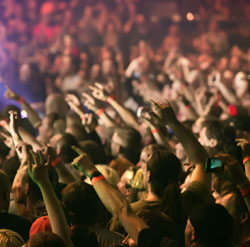
This issue is primarily caused by the sound refracting upwards when it encounters the heat generated by the audience. We know this while the prediction software (that I’m aware of) does not.
So the software is not capable of showing us the advantages of flying the system higher to reduce this issue.
A similar issue happens with flown systems for outdoor events. During the day with the sun out and the ground warmer than the air, the refraction of the high frequencies upward can cause the sound to be duller and can significantly increase the coverage area.
Later into the night, after the air has cooled and the temperature differentials have stabilized, the system gets brighter and the coverage area reduces.
I encounter this phenomenon at multistage festivals with coverage areas that are significantly changing.
Getting It Handled
So out of all this, here are a few things:
1) The sound of an acoustic space is dynamic and constantly changing due to numerous factors. I’ve primarily focused on the thermal aspect here, but other factors include wind and diffusion/absorption by humans, as well as attenuation of frequencies over longer distances due to humidity.
2) Prediction software will not deliver correct results if the real-world environment is different than the prediction environment. If the prediction is for 70 degrees (Fahrenheit) and the venue is packed tight with 90-degree humans on a 50-degree night, the average temperature may be 70 degrees but the real-world coverage will be significantly different than the predicted coverage.
3) It’s important to properly tune and align a system, but it’s perhaps more important to prepare for what the acoustical space will sound like when people arrive and the environment changes.
Here are a few things I do to be prepared for and deal with constantly changing acoustics. First, knowing that the venue sound is constantly changing, I follow a “use the correct EQ” strategy. The channel EQ is to make the mic/instrument combo sound correct for headphones and recordings.
Environmental venue changes have almost no effect on channel EQ so they stay set. I use the system processor to fix any issues with the sound of the loudspeaker system and array configuration. This is where I attempt to correct disparities in coverage distances, along with mechanical changes to the array positions.
I use a house EQ as a hands-on control to compensate for the constantly changing venue sound. Quick, easy, and accessible as the cool air makes things brighter, I can compensate. As the warm audience heats up a cold room, I can add back in the frequencies that needed to be reduced earlier in the set.
For more than a decade I’ve been carrying a long-range digital infrared thermometer to measure temperatures through the venue. I work closely with the production manager and venue staff to create a consistent thermal environment. Usually, this involves shooting for a median venue temperature of 78 to 80 degrees (F). If the venue is colder, the differential between air temp and human temp tends to cause issues. If the median temp is much higher, there’s risk of excessive heat for the audience in the upper balconies. The more consistent an acoustic space is thermally, the more predictable it will be.
I avoid hanging a single line array per side if there’s potential for wind. Line arrays tend to be highly susceptible to wind gusts blowing the sound away from the audience. Hanging two arrays per side with some overlapping coverage greatly reduces this issue.
Also, flying the PA higher tends to reduce the impact of heat issues radiating from the ground or from warm humans. And I take sound check system EQs with a grain of salt. The EQ from a previous good-sounding show in a similar venue is a much more trustworthy place to start.
Finally and most importantly, remember that a properly tuned system is one that performs correctly and sounds great from the moment the show starts and stays sounding great and covering well to the very last note. A perfectly tuned system in an empty room is about as useful as trying to serve a banquet dinner on a waterbed.
Dave Rat heads up Rat Sound Systems (www.ratsound.com), a leading sound reinforcement company based in Southern California, and has also been a mix engineer for more than 30 years.
